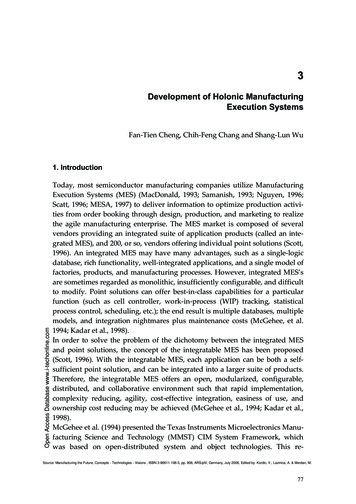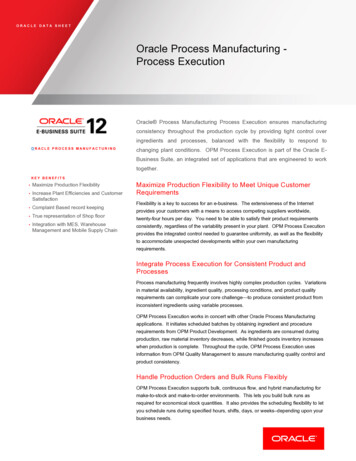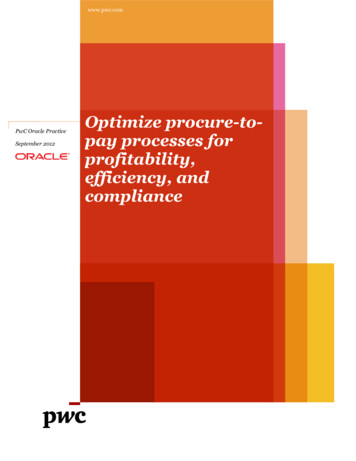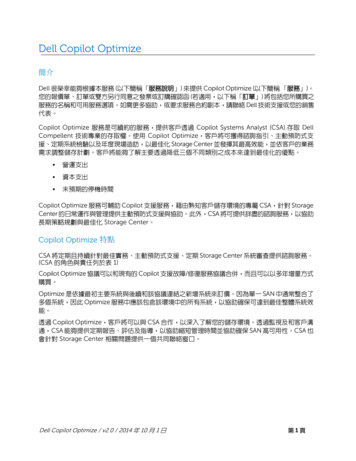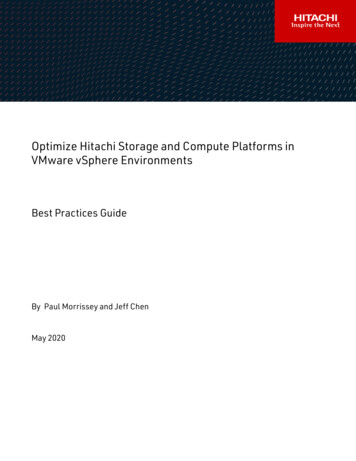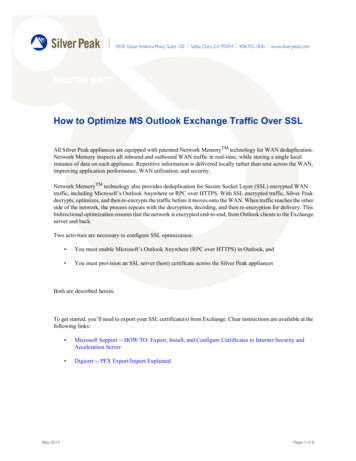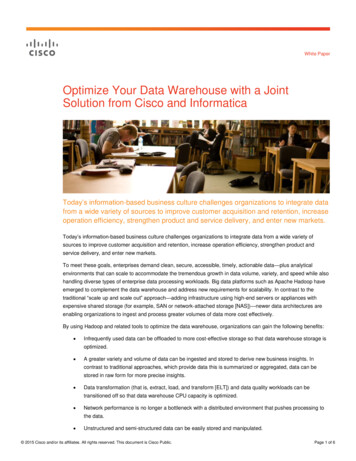
Transcription
Manufacturing Execution Systems toOptimize the Pharmaceutical Supply ChainRolf Blumenthal, Werum Software & SystemsParsippany, NJ / Lueneburg, GermanyThis article has originally been published in the German magazine“Die pharmazeutische Industrie”.Pharm. Ind. 66, Nr. 11a, 1414-1424 (2004) Editio Cantor Verlag, Aulendorf, GermanyISSN 0031-711 XOptimizing the pharmaceutical supply chain by means of MESpage 1 of 28
AbstractManufacturing Execution Systems (MES) enable the pharmaceutical industry to reduce productioncosts and increase compliance with regulatory requirements significantly. This is due to thecapability of an MES to optimize business processes in the production supply chain, improveproduct quality and ensure the safety of manufacturing processes.This article provides practical advice on how to make the implementation of an MES solution asuccess story. The article examines various production architectures and the associated processworkflows and states criteria to determine benefits and functional scope of an MES. The requiredfunctions and interfaces are listed and implementation strategies are introduced. Finally casestudies describe successfully installed MES systems and document the benefits achieved for theusers.The author Rolf Blumenthal is Vice President International Consulting with Werum Software &Systems America, Inc.Rolf Blumenthal has been working with Werum since 1979 and is one of the 15 employees whotook over the company after the death of the company founder Wulf Werum in 1982. He hasgained outstanding expertise in the management of large-scale and international MES softwareprojects for Pharma and Biotech industries.For more than five years Rolf Blumenthal has managed the product development for Werum'sMES software suite PAS-X. In this context, compliance with GMP and FDA requirements is ofprime importance. Since PAS-X is operated as an Electronic Batch Recording System in thepharmaceutical industry the guidelines of the GAMP Community are of particular relevance for theproduct development process.Since Rolf Blumenthal is a renowned industry expert with hands-on experience andcomprehensive technical expertise he started international consulting activities in 2005. In this rolehe advises PAS-X customers on the following major topics: IT architectural blueprints, systemintegration, computer system validation, optimized use of PAS-X, and efficient creation of masterbatch record libraries.Rolf Blumenthal is a member of the GAMP D-A-CH Forum where he is actively participating aseditor and reviewer of new guidelines. Since 2002 he has been a member of the GAMP D-A-CHSteering Committee and of the Special Interest Group “Validation of Small Manufacturing andWeighing Devices”.Optimizing the pharmaceutical supply chain by means of MESpage 2 of 28
Contents1 Introduction . 42 What are the Benefits of an MES System?. 62.1 Objectives . 62.2 Various Production Architectures . 72.2.1 Architectural Design of Biopharmaceutical Production . 72.2.2 Architectural Design of the Production of Pharmaceutical DosageForms . 82.3 Classification and Assessment . 103 Positioning within IT environment . 113.1 Overview of Standards ISA S95.00.01/02/03. 113.2 ISA-Compliant MES Integration . 143.2.1 Integration with an ERP System . 143.2.2 Equipment Integration . 154 Functional Packages . 174.1 Functions Required on MES Level . 195 Regulatory Requirements . 216 Implementation Strategy . 227 Case Studies. 237.1 Production of Pharmaceutical Solids - Bayer Health Care . 237.1.1 Purchased Software to Profit from the Experience of Other Users. 237.1.2 A Focus on Flexible Processes . 247.1.3 The Reality of Electronic Documentation. 247.1.4 Integrated Systems . 247.1.5 Wrap-up. 257.2 Biotechnical Production - Boehringer Ingelheim. 257.2.1 Biotechnological Requirements . 257.2.2 Coordinating Complex Processes Safely. 267.2.3 Manual and Automatic Sequences Alternating. 267.2.4 Suitable to Meet Future Requirements . 278 Outlook. 27Optimizing the pharmaceutical supply chain by means of MESpage 3 of 28
1 IntroductionAs a production manager or having a similar position in the pharmaceutical industry you might befamiliar with a setting like this: Long rows of files with paper documents, some of them still partlyunprocessed; colleagues constantly asking you "What do I have to do next"; and not to forget thepermanent discussions with the sales department on which products are required urgentlytomorrow.Would you not prefer a situation like this: your personnel is equipped with RF hand-held terminalsand can inquire the activities next in line at any place and at any time; your operators thus executethe required activities as specified. And on top: a complete, electronic documentation and astatement about the performance and status of your production and packaging upon the click of abutton.A Manufacturing Execution System (MES) is at the core of such a scenario. An MES controls,optimizes, and documents business processes executed on the shop floor in full compliance withall the pharmaceutical requirements. It is the goal of an MES to increase security and reliability ofthe manufacturing process and to improve product quality. MES solutions are suitable for differentprocesses including chemical or biochemical manufacturing of active pharmaceutical ingredientsas well as the subsequent processing of such APIs in solid and liquid pharmaceutical forms.MES solutions are not isolated but a core component of the entire supply chain IT architecture. In1998, AMR created the REPAC Model (Ready, Execute, Process Control, Analyze, Co-ordinate)and thus laid the foundations for the basic understanding of the necessity to use an MES. Anautonomous MES enables the support and optimization of business processes by means ofsoftware functions. To actually achieve such potentials and optimize the IT architecture on the longrun, it is necessary to standardize the functions and workflows in logical units. Typical examples ofsuch a view are Weighing & Dispensing, Electronic Batch Recording, Equipment Management,Deviation Management with CAPA functions (Corrective Actions / Preventive Actions).Optimizing the pharmaceutical supply chain by means of MESpage 4 of 28
Figure 1: The REPAC model (Ready, Execute, Process Control, Analyze, Coordinate)laid the foundations for an MES (source: AMR)A Manufacturing Execution System is an electronic interface between personnel, equipmentautomation, orders, logistics, equipment and processing instructions (batch records). Thus, theMES is located between the company-wide Enterprise Resource Planning System (EPR) and theprocess control systems (DCS). The MES mediates between business administration (coveringcore functions such as sales and production planning or controlling) and the automation of theproduction process.Optimizing the pharmaceutical supply chain by means of MESpage 5 of 28
2 What are the Benefits of an MES System?The implementation of a complex MES solution involves large investments. Therefore, somequestions have to be answered to justify these costs. How can the user determine the necessity ofan MES and how does the user benefit from an MES? Only measurable and quantifiableadvantages can provide an economic investment justification.In this context, a systematical procedural approach is essential. Objectives have to be defined andtypical characteristics of the examined plant and the involved business processes have to beanalyzed. The information obtained in such a matter is a solid basis for an objective assessment ofthe benefits provided by an MES.However, despite the importance of such a structured approach it cannot be denied that thedecision for or against the benefits of an MES system frequently involve factors that are notmeasurable in economic terms.2.1ObjectivesTypical goals to be achieved by the implementation of an MES system are: Optimizing of the entire supply chain with the MES system best suitable for controllingworkflows and procedures Improving process safety and reliability Recognition of deviations at an early stage Immediate documentation of process steps Improved data quality for assessing processes and products Visibility and transparency throughout the entire production process: only deviations are to beanalyzed, a detailed examination of the normal flow of operations is no longer required Reduction of storage costs due to reduced lead times (WIP) Reduction of administrative work for maintaining manufacturing documents Creating and approving master batch records Reducing the number of lost batches Reduction of operating costs due to a high level of integration and thus prevention of isolatedsolutions Rapid access to current data: management based on up-to-the-minute information for allcritical business cases Complete 21 CFR Part 11 compliance also for lower-level systemsOptimizing the pharmaceutical supply chain by means of MESpage 6 of 28
2.2Various Production ArchitecturesIn pharmaceutical production there are typical production structures for manufacturing activepharmaceutical ingredients or dosage forms such as tablets, ointments or liquids. These structurescan be classified according to specific criteria. This classification can be used to define thedifferent benefits levels of an MES for a particular production architecture in detail and by degrees.Moreover, such a classification also leads to different implementation concepts for an MESsystem. It would be wrong to claim that there is one software solution to provide optimal supportfor the respective type of production.Obviously, such structures can only be regarded in a rather abstract way. Thus, in concrete casesthere may be deviations from the general patterns. For this reason, it is always advisable toanalyze a concrete example.In this article, we only consider regulated production areas operating on the basis of master batchrecords. The examples we use refer to the biopharmaceutical production of active pharmaceuticalingredients and the production of solids. Similar structural descriptions could be established for theproduction types we cannot regard in this paper.2.2.1 Architectural Design of Biopharmaceutical ProductionBiopharmaceutical production of active pharmaceutical ingredients is characterized by naturalfermentation processes of germs. Depending on the progress of the process the results of aprevious phase have to be distributed onto additional equipment that is getting larger with everystep.Optimizing the pharmaceutical supply chain by means of MESpage 7 of 28
Figure 2: Biopharmaceutical API production – principle structureCharacteristic features of biopharmaceutical production: Highly automated production Sub recipe control by means of a DCS Few manual material transports The process is running "on rails" with just a few buffering possibilities Production requires a reliable verification of the cleaning status of all the different equipment Equipment management2.2.2 Architectural Design of the Production of Pharmaceutical Dosage FormsOne of the characteristics of the production of pharmaceutical dosage forms is the material flowusing containers. The master batch records states fixed batch size limits related to the containersize. The input material quantities and the further operations are based on these limits.Following the weighing/dispensing of material into a container it is transported from work centre towork centre where it is processed according to specification. Sometimes the production workflowOptimizing the pharmaceutical supply chain by means of MESpage 8 of 28
in the building involves several floors. Some containers are transported in lifts and in some casesthe force of gravitation facilitates material transfer.Figure 3: Production of pharmaceutical dosage forms – principle structureCharacteristic features of a manufacturing process for pharmaceutical dosage forms: A large number of work centers–5-10 granulators–20-40 tabletting m
integration, computer system validation, optimized use of PAS-X, and efficient creation of master batch record libraries. Rolf Blumenthal is a member of the GAMP D-A-CH Forum where he is actively participating as editor and reviewer of new guidelines. Since 2002 he has been a member of the GAMP D-A-CH Steering Committee and of the Special Interest Group “Validation of Small Manufacturing and .
